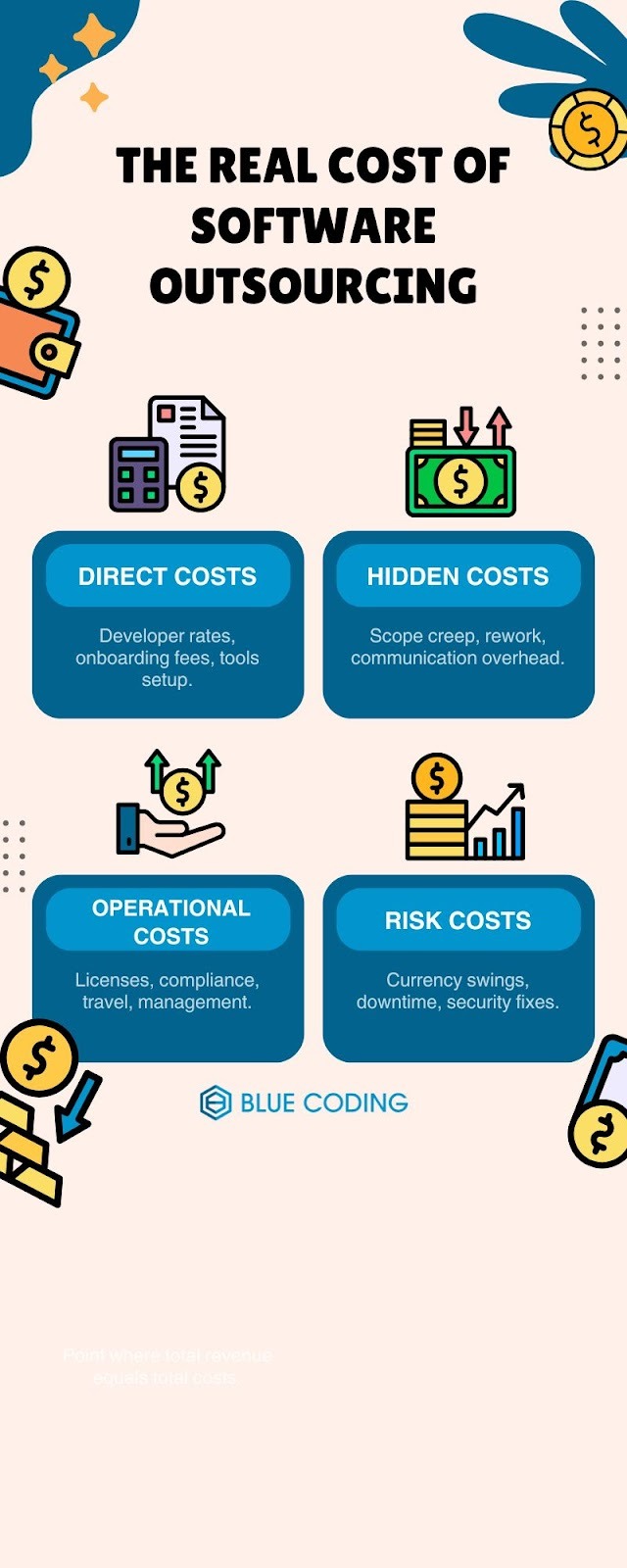 News
News
Outsourcing software development often looks like a quick way to get expert help and save money. But if you only focus on the price, you’ll miss the hidden costs and challenges that come with it. This nearshore outsourcing comprehensive guide breaks down what software outsourcing really means, reveals the hidden expenses many don’t talk about, and shows you how to calculate the total cost before you sign any deal. Whether you’re thinking about nearshore teams or other options, knowing the full picture will help you make smarter choices and avoid surprises.
What Is Software Outsourcing Really?
Software outsourcing is when you bring in an external team, often located in another country, to build, manage, or scale your software projects. It’s basically about accessing specialized talent you might not find locally, whether that’s in AI, cloud architecture, UX, or mobile development. This approach allows your internal teams to stay focused on core goals while the outsourced team handles the technical workload. It also gives you the flexibility to scale your development efforts up or down based on project needs without committing to long-term hires. The right outsourcing partner brings in established processes, risk controls, and compliance standards that reduce operational stress. And when your teams are spread across time zones strategically, development can happen almost 24/7.

The Hidden Costs of Outsourcing Software Development No One Talks About
Outsourcing sounds like a budget win on paper: faster delivery, lower hourly rates, and less internal load. But when the project actually starts rolling, the fine print shows up in unexpected places. Suddenly, you're paying for extra calls, redoing features, patching quality gaps, or chasing down undocumented code. These aren’t mistakes. They’re hidden costs baked into most outsourcing setups. If you’re not actively looking for them, they’ll quietly drain your time, energy, and budget. Here’s what to really watch out for.
1. Onboarding and Transition Overruns.
Outsourcing doesn’t begin when you sign the contract. It begins when the new team starts integrating into your system, and that takes time, effort, and money. From setting up access credentials and project documentation to onboarding them with your business goals and internal tools, this process often stretches longer than planned. And if you're switching from one vendor to another midway through a project, the handover costs stack up even more. What looks like a quick start on paper often ends up as a resource-heavy ramp-up period that eats into your budget without delivering any code yet.
2. Integration and Customization Fees.
Not every outsourcing partner can work with your tech stack straight out of the box. If your systems are custom-built or rely on third-party APIs, you’ll probably end up paying extra for someone to build connectors, configure endpoints, or create custom middleware. And let’s not forget those quirky legacy systems that were never meant to be integrated with anything modern. These “small customizations” are rarely included in your initial quote, but they creep in quietly, dragging your deadlines and budget with them.
3. Scope Creep and Change Orders.
You might think a minor update or a small feature tweak is harmless. But with most outsourcing vendors, every change requires paperwork, approvals, and additional charges. These aren’t free favors. They’re tracked, billed, and often negotiated in a separate round of talks. What starts as a “just one more thing” quickly becomes a string of change requests, each carrying its own cost. And before you know it, the initial estimate is no longer relevant. Nevertheless, with the right partner, outsourcing can help you reduce your development costs by 30-40%.
4. Communication and Management Overhead.
When your developers are on the other side of the world, talking to them isn’t always easy. Time zone differences delay responses. Language barriers lead to misunderstandings. Cultural mismatches change how people ask questions, solve problems, or report issues. And to keep everything aligned, you’ll need extra project managers, translators, or internal liaisons. You might also need to invest in better communication tools, project dashboards, and daily stand-up systems just to keep things moving at a normal pace.
5. Quality Lapses and Rework.
Speed over quality is a common outsourcing trap. Sometimes corners get cut, tests are skipped, or user flows are ignored in the rush to deliver something on time. And what follows? Rework. Bugs that need patching. Entire modules that must be rewritten. These quality issues may not show up immediately, but they surface during user testing or, worse, after release. Fixing them not only adds cost but also strains your timelines and resources.
6. Security, Compliance, and IP Safeguards.
If your outsourced partner doesn’t follow proper data protection standards, you could be the one held liable. Whether it’s HIPAA, GDPR, or your industry’s own compliance codes, ensuring every box is ticked means investing in audits, certifications, and legal protections. Then there’s intellectual property. You’ll likely need NDAs, copyright clauses, and legal reviews to ensure your product isn’t reused elsewhere or put at risk. And all of this? It rarely comes bundled with your base outsourcing package.
7. Currency Risk and Exchange Fluctuations.
Outsourcing often means paying in foreign currencies. What looks like a great rate today can turn into a financial headache if the exchange rate shifts. A strong local currency means you’ll be paying more for the same service every month. Unless you’ve built in financial buffers or currency hedging, these fluctuations will catch you off guard. It’s a hidden cost that lives outside the contract but still affects your bottom line directly.
8. Vendor Lock-In and Knowledge Silos.
Outsourced teams sometimes build systems in ways that only they understand. They might use proprietary tools or avoid documenting their code thoroughly. And when it’s time to move on or bring things in-house, you're stuck. Transitioning to a new team means reverse-engineering code, untangling third-party dependencies, and spending time just to understand how things work. What should be a simple shift becomes a full-blown knowledge recovery mission, costing you more than you planned.
9. Post-Delivery Maintenance and Support.
Just because the product is delivered doesn’t mean the costs stop. Software needs updates. Operating systems change. New device resolutions come into the market. Users discover bugs. And unless you’ve explicitly contracted ongoing support, you’ll be paying separately for every fix, every patch, and every minor update. This post-launch phase often turns out to be more expensive than development itself if it's not budgeted correctly.
10. Governance, Oversight, and Reporting.
Keeping things running smoothly requires more than just technical output. You’ll need to monitor performance, ensure contract compliance, attend regular meetings, and run periodic audits. All of this governance work adds hours to your internal teams or forces you to hire additional oversight. Legal teams might need to get involved. Admins may be needed to manage documents, payments, and milestones. And while none of these roles write a single line of code, they’re crucial and costly.
11. Disaster, Compliance, or Political Shocks.
Outsourcing across borders means you’re also importing their risks. Natural disasters, political unrest, internet blackouts, or sudden regulatory changes can hit your vendor hard. When that happens, you might have to pay for emergency backups, shift resources, or even relocate your operations temporarily. These disaster-related costs are unpredictable but very real. Planning for them is tough. Recovering from them is even tougher.
12. Cultural and Strategic Misalignment.
Every country has its own work culture. How fast people respond, how decisions are made, and how deadlines are treated are some of the differences you may spot. When there’s a mismatch, it slows things down. You may find yourself needing extra alignment meetings, cultural sensitivity sessions, or even strategic recalibration. In extreme cases, the disconnect becomes so wide that teams stop collaborating effectively, leading to miscommunication and missed goals that cost you more than just money.
13. Hidden QA, Testing, and Overtime Fees.
Outsourcing quotes often include basic testing, but real-world software needs deeper quality assurance. Manual test runs, security penetration tests, bug bounty programs, and third-party testing tools are often billed separately. Also, if deadlines slip and you ask for overtime or weekend work, expect that to come at a premium. These fees creep in later and are often excluded from your original budget discussions.
How To Calculate the Real Cost of Software Outsourcing
To calculate the true cost of software outsourcing, start by listing all direct and indirect expenses, hourly or fixed-rate labor fees, setup charges for onboarding and tools, integration work, and vendor management. Then layer in the ongoing operational costs like licenses, remote management tools, communication platforms, travel for sync-ups, and compliance or legal services. Don’t forget to build in a buffer, around 10 to 20 percent of the total, as a contingency fund for scope changes, quality rework, or timeline shifts. Add the financial impact of risks too, including currency swings, downtime from external disruptions, and quality hiccups that slow progress. Sum it all up, compare it to what staying in-house would cost, and you get the real Total Cost of Ownership, not just your vendor’s invoice, but the full picture of what outsourcing will actually cost over time.
Why Choose Blue Coding as Your Outsourcing Partner?
Blue Coding respects and prioritizes creating reliable, long-term partnerships that drive real business results. With extensive experience in nearshore outsourcing, we guide companies through the hidden costs and challenges to ensure projects are delivered on time and within budget. Our expert teams combine strong technical skills, transparent communication, and streamlined processes to keep your goals front and center. Ready to find a smarter outsourcing solution? Contact us today and let’s get started with a free strategy call!



